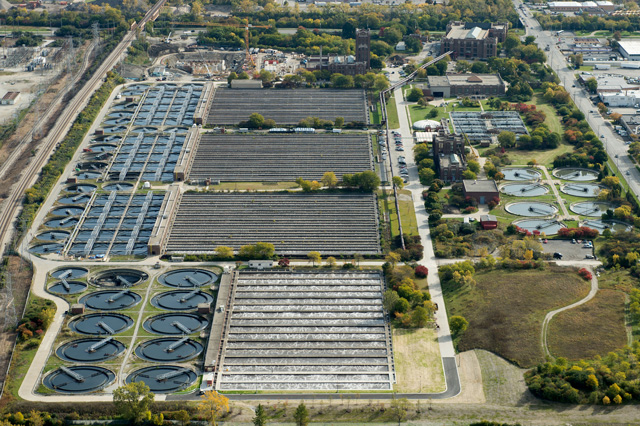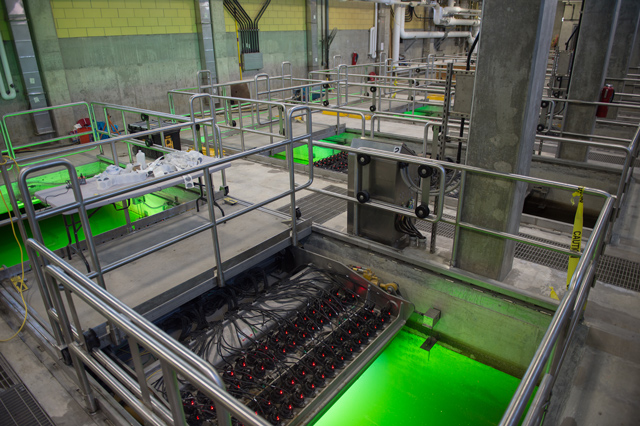Terrence J. O'Brien WRP

The main portion of the Terrence J. O'Brien Water Reclamation Plant (WRP) began operation in 1928 and was a model for modern sewage treatment technology. Formerly known as the North Side WRP, the plant serves today more than 1.3 million people residing in a 143-square-mile area that includes Chicago, north of Fullerton Avenue and the 17 suburbs in northern Cook County. The O'Brien WRP removes pollutants from wastewater through a series of physical and biological processes. The plant cleans an average of 230 million gallons of wastewater per day (mgd) and has the capacity to treat 450 mgd.
Water entering O’Brien WRP passes through coarse screens to filter out large debris, followed by pumping and primary settling, which includes further screening, grit removal and separation of solids from the water in which aerated grit tanks and primary settling tanks remove fats, oils and solids. In secondary treatment, microorganisms remove organic material from the water as oxygen is pumped into aeration tanks. Solids then settle at the bottom and clean water flows out the top of secondary settling tanks.
The water is then disinfected through a tertiary process that uses via ultraviolet (UV) irradiation. In 2016, the O’Brien WRP introduced this new disinfection technology that neutralizes microbes in the water that flows through seven channels in a state-of-the-art facility. Each channel has the capacity to disinfect 75 mgd using UV light. With two banks of lights per channel and 64 bulbs per bank, there are a total of 896 bulbs installed in the facility. The O’Brien facility is now the largest UV disinfection facility for a wastewater plant in the U.S. The cleaned water is then released into the North Shore Channel. The whole process of converting raw sewage into clean water takes an average of about 12 hours from the time it enters the plant to being processed, cleaned and released. Although the disinfection facilities operate differently than at Calumet WRP, which uses chlorination/de-chlorination, each will drastically improve the quality of the region’s waterways. To read more about the opening of the new facility, visit here.
As 21st century innovation has intertwined with the water reclamation process, the MWRD has invested in new strategies at O’Brien that embrace the agency’s goal of energy neutrality and extend beyond simply treating water. The MWRD is currently supporting leading-edge research at O’Brien to help make algae technology a practical and sustainable approach to nutrient management for urban wastewater treatment. Algae naturally uptakes phosphorus and nitrogen from water to support its growth through photosynthesis, utilizing the sun as its energy source. This same approach can be applied to wastewater treatment as a means to remove phosphorus from the waste stream without the use of inorganic chemicals or additional energy, which is the current means of nutrient removal. The algae can be harvested and utilized in the manufacture of a variety of products such as biofuels and bioplastics, which reduce the reliance on petroleum. It can also be used as fertilizer, in a digester, or as aquaculture feed, which returns the phosphorus to the nutrient cycle.
In another groundbreaking application at O’Brien, the MWRD is working with GE Water & Process Technologies to evaluate the performance of a new membrane-aerated biofilm reactor (MABR) technology called ZeeLung. The MABR process employs a gas transfer membrane to deliver oxygen to a biofilm that is attached to the outside surface of the membrane. The microorganisms in the biofilm remove nutrients and organics in the wastewater by metabolizing them in the presence of oxygen. The technology is being evaluated for its potential to increase existing aeration tank capacity by providing nitrification in a smaller tank volume than that required by conventional treatment, effectively expanding the capacity of the existing aeration tanks to institute enhanced biological phosphorus removal (EBPR) to meet future effluent phosphorous limits without the need to construct additional infrastructure. The MABR has the added benefits of improving performance for Total Suspended Solids (TSS) and ammonia removal during stressed conditions, especially cold temperature peak flow periods. A significant benefit of this MABR technology is the potential to reduce the energy consumption required for aeration by about 40 percent compared to the current mode of operation. The MWRD is the first major wastewater agency to test this technology. Pending the results of the demonstration project, the MWRD plans to move forward with full-scale implementation at the O’Brien WRP with significant savings. Initial projections show that electricity usage will be reduced by 15 million kWh per year if the technology is fully deployed at the O'Brien WRP. With the reduction in electricity usage comes a reduction in greenhouse gases.
To learn more about O’Brien WRP, visit here.

New ultra-violet technology implemented in 2016 at O'Brien Water Reclamation Plant will provide another layer of protection by disinfecting treated water that flows through channels that emit a green glow as a result of the system being optimized for light in the UV spectrum and not normal visible white light.
| National Association of Clean Water Agencies | |
2018 |
Platinum Award for 100% Compliance with National Pollutant Discharge Elimination System Effluent Standards. |
|
2017 |
Platinum Award for 100% Compliance with National Pollutant Discharge Elimination System Effluent Standards. |
2016 |
Platinum Award for 100% Compliance with National Pollutant Discharge Elimination System Effluent Standards. |
|
2015 |
Platinum Award for 100% Compliance with National Pollutant Discharge Elimination System Effluent Standards. |
|
2014 |
Platinum Award for 100% Compliance with National Pollutant Discharge Elimination System Effluent Standards. |
|
2013 |
Platinum Award for 100% Compliance with National Pollutant Discharge Elimination System Effluent Standards. |
|
2012 |
Platinum Award for 100% Compliance with National Pollutant Discharge Elimination System Effluent Standards. |
|
2011 |
Platinum Award for 100% Compliance with National Pollutant Discharge Elimination System Effluent Standards. |
|
2010 |
Platinum Award for 100% Compliance with National Pollutant Discharge Elimination System Effluent Standards. |
|
2009 |
Platinum Award for 100% Compliance with National Pollutant Discharge Elimination System Effluent Standards. |
|
2008 |
Platinum Award for 100% Compliance with National Pollutant Discharge Elimination System Effluent Standards. |
|
2007 |
Platinum Award for 100% Compliance with National Pollutant Discharge Elimination System Effluent Standards. |
|
1993 |
Outstanding Operations Award for Sidestream Pool Aeration Stations. |